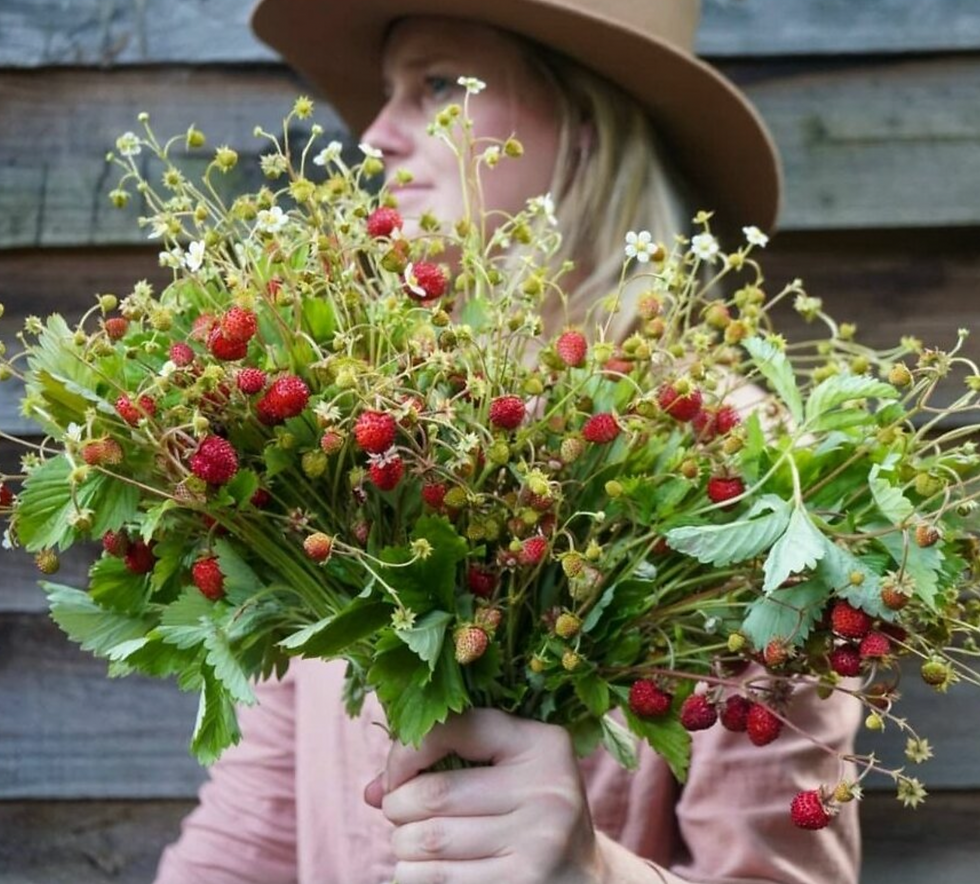Alpine Strawberry
Fragaria vesca 'Alexandria'
Alpine strawberries from seed.
Day-neutral. A gourmet treat and easy landscape plant. These decorative little plants produce delicious, aromatic red strawberries, about twice the size of wild berries but much smaller than the standard type.
Perennials, Alpine strawberries stay compact and produce few runners, making them suitable for rock gardens, path edgings, pots, and window boxes.
They begin producing the second spring, sometimes the first fall.
Grows best in Zones 5-8.
Details:
Site: Full Sun
Seed Depth: Surface, press into the soil
Plant spacing: 12-18"
Row spacing: 3'-4' Feet apart
Approx seeds per packet : 50
• Edible Flowers: Flowers add a mild, strawberry-like flavor if sprinkled on salads or when used as a garnish for drinks and desserts.
Culture:
Strawberries prefer a sunny to partially shaded location and moist, well-drained soil, richly fertilized with compost or aged manure, and a pH between 6.5-6.8. Prepare beds the previous fall or in early spring to get good control over perennial weeds.
Sowing:Sow seeds thinly in March or April in a fine soilless mix. Press seeds into moist mix and keep moist until plants emerge in 2-3 weeks. Keep soil temperature between 60°F (16°C) and 75°F (24°C), if possible. Transplant to plug trays or 1-1 1/2" apart in flats, then to larger pots or planters for retailing full-size plants: 1 plant/3-4" pot; 3-5 plants/8" pot. Transplant outdoors anytime, 1' apart.
Planting(Plants):Space plants 12-18" apart in rows 3-4' apart. Some growers prefer to plant the crowns with closer spacing (5-9" in-row spacing for single rows or staggered double rows with 10-20" in-row spacing) and to remove all runners during the entire life span of the bed. Set plants with the roots straight down into the soil, making sure the middle of the crown is level with the top of the soil. Irrigate and keep free of weeds. Mulch with straw in late fall when plants have started to go dormant to moderate freeze/thaw cycles and heaving. Pull mulch aside in spring when plants start to grow. Leave the mulch in the aisles to keep the fruit clean and help suppress weeds.
Harvest:Plants will set fruit from midsummer through October. Production and berry size may decline during the hottest part of summer. Day-neutral beds will last for one to two growing seasons once established.
Notes:Encourage the plant to put its energy into becoming established by removing all the flower buds for the first 6 weeks after setting out your plants. We also recommend that you remove all the runners during the first year.
Alpine Strawberry - Fragaria vesca 'Alexandria'
Using the berries as herbal medicine is not especially common today, but the berries are often used in conjunction with other medicinal herbs in so-called blood-purifying teas.
In addition, the berries have been used as an herbal remedy for gout, arthritis, throat inflammation and kidney disease. They are also thought to improve digestion and act as a general tonic.
The berries have also been used cosmetically in skin care creams to restore and strengthen the skin, reduce wrinkles, bleach freckles and relieve sunburns.
The juice of the fruits has been used as a natural treatment for chilblains, and fresh strawberries have been used to remove tartar and discoloration on the teeth.
Since the fruits are rich in iron and potassium, they can be a good addition to the diet of those suffering from anemia.
The young leaves can be eaten, either raw or cooked. The fresh or dried leaves can be used to make a tea that tastes delicious and is suitable for children.
The leaves of wild strawberries are mildly astringent (contracting), diuretic and are considered to have blood-purifying properties.
An herbal tea made from the leaves has been used internally to relief diarrhea, gastroenteritis, ailments of the urinary tract and hemorrhoids.
The tea has also been used as a gargle to relief bad throat, gum inflammation and mouth ulcers (canker sores), and externally to treat minor burns, cuts and scrapes.

